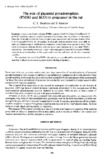| dc.contributor.author | Bambra, CS | |
| dc.contributor.author | Gombe, S | |
| dc.date.accessioned | 2013-06-25T06:37:51Z | |
| dc.date.available | 2013-06-25T06:37:51Z | |
| dc.date.issued | 1978-05 | |
| dc.identifier.citation | J Reprod Fertil. 1978 May;53(1):109-15. | en |
| dc.identifier.uri | http://hinari-gw.who.int/whalecomwww.ncbi.nlm.nih.gov/whalecom0/pubmed/641888 | |
| dc.identifier.uri | http://erepository.uonbi.ac.ke:8080/xmlui/handle/123456789/39375 | |
| dc.description.abstract | Treatment of rats with anti-PMSG and anti-hCG for 5 days from Days 6, 11 or 16 of pregnancy caused variable necrosis of fetal tissue, the extent of which increased from the chorionic cells to the inner trophoblastic layers with the increase in dose from 4 to 10 mg anti-PMSG. At 10 mg/day, fetal death and resorption were invariable in early to mid-pregnancy, whilst in late pregnancy some litters were carried to term. The main histological change in the corpora lutea was hyperaemia in the anti-PMSG-treated rats. Immunofluorescence studies with conjugates of anti-hCG and anti-PMSG showed sharp localization in the giant and chorionic cell layer at the feto-maternal junction. We conclude that an hCG/PMSG-like substance is produced by rat chorionic cells and that it plays an immunosuppressive role during pregnancy. | en |
| dc.language.iso | en | en |
| dc.publisher | University of Nairobi. | en |
| dc.title | The role of placental gonadotrophins (PMSG and hCG) in pregnancy in the rat. | en |
| dc.type | Article | en |
| local.publisher | Department of Animal Physiology | en |

